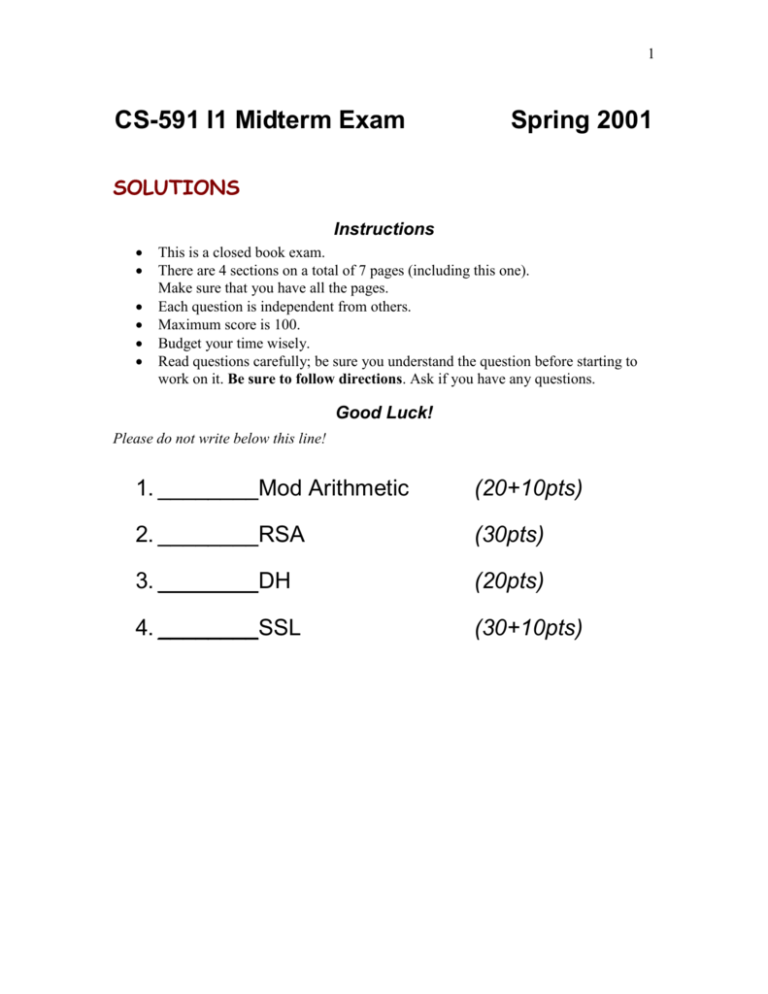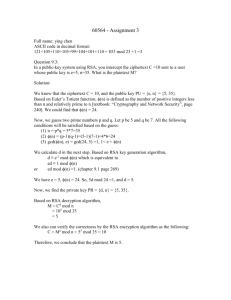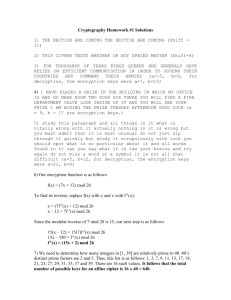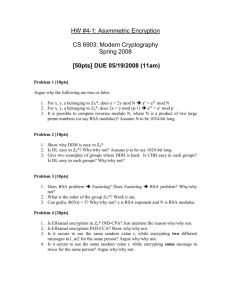cs591-01-Midterm
advertisement

1
CS-591 I1 Midterm Exam
Spring 2001
SOLUTIONS
Instructions
This is a closed book exam.
There are 4 sections on a total of 7 pages (including this one).
Make sure that you have all the pages.
Each question is independent from others.
Maximum score is 100.
Budget your time wisely.
Read questions carefully; be sure you understand the question before starting to
work on it. Be sure to follow directions. Ask if you have any questions.
Good Luck!
Please do not write below this line!
1. ________Mod Arithmetic
(20+10pts)
2. ________RSA
(30pts)
3. ________DH
(20pts)
4. ________SSL
(30+10pts)
2
1. Modular Arithmetics (20+10 points)
a. Compute 3201mod 11. (hint: use Fermat’s theorem)
By Little Fermat Theorem, 310 mod 11 = 1.
So, 3201 mod 11 = 31 * (310) 20 mod 11 = 3
b. Compute 2802mod 505. (hint: 505=101*5)
Similarly to the above, but now using Euler’s theorem:
2(505) mod 505 = 1.
(505)= 400.
So, 2802 mod 505 = 22 = 4
c. Extra Credit: What is gcd(n,n+1)?
Let d be a divider of n, so d=i * d
If d also divides n+1 then it must divide (n+1)-n=1.
Therefore, d=1. Namely, any common divider of n, and n+1 must
be equal to 1.
So, gcd(n, n+1)=1
An even simpler (but less direct) way to see it is by applying
Euclid’s gcd algorithm: gcd(n, n+1) = gcd( n+1 %n, n) = gcd(1,n)=1.
3
2. RSA (30 points)
a. Given RSA signatures X and Y for messages x and y, compute the
signature of message x*y. (Assume there is no hashing: i.e. X=xd mod n
for some unknown private exponent d and the public modulus is n)
Signature of x*y is equal to
(x*y)d mod n = xd * yd mod n = X*Y mod n
b. Suppose, Amason is using RSA with modulus n and public exponent e.
One day they are hacked, and their private key d becomes known to the
attackers. Bob, the security consultant, suggests that instead of
regenerating the new keys completely from the scratch, only the new
exponents e’, d’ need to be re-computed, leaving the modulus n
unchanged (after all, indeed modulus computation requires more work).
Is this safe? If yes, explain why. If not, show how the pirates can
compromise the new system (i.e. compute new d’ from e, d, n, e’).
Not safe: Bob clearly has not taken this class. We discussed in
class the scenario of using the same modulus for many users
and why it is not secure. This is essentially the same issue here.
We know that e*d mod (n) =1.
Suppose, (using extended gcd) you found x such that
x*e’ mod (e*d–1) = 1
Then x*e’ mod (n) = 1, so x=d’.
If extended gcd returns r>1, then try to find x again, now using
(e*d-1)/r in place of (e*d–1).
The above describes how attackers can determine the private
key corresponding to any public key.
c. Attacker Attila intercepted some packets c1,c2, …, ck, encrypted using
RSA with public exponent e and modulus n=pq (i.e. Attila knows only
ciphertexts, n, e, but not p, q). His spies also learnt that one of the plaintext
packets mi (for some i, s.t. ci=mie mod n) is divisible by p.
Can Attila decipher all intercepted packets now? How or why not?
Yes, Attila can now factor n as follows, and thus decipher not
only the intercepted packets but also all the other messages
encrypted with the same keys:
4
For each ci compute ri = gcd(ci,n). If 1< ri <n, then ri = p. This will
be the case for i for which mi is divisible by p. Indeed, if mi =
p*k, for some integer k>0, then ci=mie mod n = peke mod (p*q).
Therefore, ci is also divisible by p.
We do need to note two possible “failures” for Attila: if mi
which is divisible by p is either 0 or n. In either of those case
Attila would learn nothing. But these two cases are “illegal”
messages since neither message is in Zn*.
5
3. DH (20 points)
a. Turn DH scheme into a public key encryption system: i.e. specify the
Public Key P, Private Key S, and algorithms EncryptP(M) taking the
public key P and message M and encrypting it, and DecryptS(C) taking
private key S and encrypted message (ciphertext) C and decrypting it.
P= <p, g, ma= ga mod p >
S= <p, g, a >
EncryptP(M):
bRandom {1,…,p-1}
K mab mod p
c M*K mod p
mb gb mod p
C <c, mb>
Return ( C )
DecryptS(C):
a
K mb mod p
M c/K mod p
Return( M )
# Let C=<c, mb>
# to divide by K: compute K-1 using ExtGCD
b. Can the above public key encryption be turned into the signature as easily
as for RSA encryption scheme is turned into signature: for RSA public
(encryption) key becomes the verification key and the private (decryption)
decryption key becomes the signing key?
If yes, show the resulting signature scheme; if not, explain why.
(ElGamal and DSA are more complex transformations of DH than what is
asked for above)
It is hard to turn the above algorithm into Signature in the
most direct way. For RSA, to sign a message we simply apply
RSA-Decrypt algorithm to it, and to verify RSA-Encrypt. Here
this would not work, since the decrypt algorithm requires mb
which is generated by the other party. In the translation, it
would require input from Verifier to generate a signature.
6
Putting it differently, DH is turned into an encryption scheme
easily, because the messages from one party are turned into
the Public Key, and it is the other’s party move first (i.e. to
encrypt). Thus the party acting first (encrypting) has all the
necessary info already. For Signature, the party which has the
Public Key must “move” first, but it has no input from the other
party at that stage. So, DH cannot be emulated in this scenario.
4. SSL (30+10 points)
Consider the following threats to web security and briefly (but concisely!) describe how
these are addressed in SSL (if possible, start by a specific SSL message(s) used to address
the threat; also, some are really as simple as they look):
a. Man-in-the-Middle.
This is prevented by authenticated (relevant) handshake
messages. Namely, the Server’s Certificate message contains
Server’s Public Key (PK), authenticated by a trusted CA. If RSA
is used, then the PK is the encryption key, so that when the
client encrypts ClientKeyExchange message, he can be sure that
the Man-in-the-Middle would not be able to decrypt this
message. If DH is used, then the Server’s DH message (either
part of Server’s Certificate or ServerKeyExchange) is
authenticated (once again the trust is rooted in CA via
certificate). Thus authenticating even just the server excludes
Man-in-the-Middle attack.
b. Replay: earlier SSL handshake messages are re-used (replayed).
Replay attack is eliminated by using random values in ClientHello
and ServerHello, and using these values for master secret
generation and authenticating the handshake exchanges in MAC
of the Finished messages (where the MACs are protected by
encryption).
c. Confidentiality: preventing attacker from getting the transmitted
information.
Confidentiality is achieved by encrypting the data exchanged by
7
Server and Client (after ChangeCipherSpec message) with the
keys derived from master secret. The master secret is derived
by using the public key cryptography (DH, RSA) and excluding
man-in-the-middle attack (see above).
d. Brute-force attack: exhaustive search of all keys, for each, trying to
decrypt the intercepted message
Brute force attacks are prevented in general by making sure
that the keys used are sufficiently long, so enumerating all the
possibilities for them is infeasible.
i. For Key Exchange.
For key exchange this means selecting keys as long as
1024 or more bits for the modulus. This is done in part
because the mathematical nature of the algorithms opens
up attacks more efficient than the simple enumeration of
all possible keys.
ii. For symmetric (conventional) encryption.
For symmetric keys, over 80 bits is considered
sufficiently long for the keys for the most
straightforward enumeration of the keys. 56 bits – as
used by DES – is no longer considered to be safe, but it
still requires considerable resources to attack. Most
modern ciphers use 128 bit keys or even more.
e. Known-plaintext attack: Some messages sent over an SSL connection can
be predictable (e.g. HTTP GET). An attacker can build a dictionary of
every possible encryption for each such known plaintext message. Each
intercepted message (or its segment – how long such a segment should
be?) is looked up in the dictionary, and if a match is found, then the
corresponding key is used. If there are a few matches, then all the keys
must be used on longer intervals, to determine which is correct.
In order to mount even an exhaustive search attack requires
knowing when a correct key is discovered. This can be achieved
by various variations of the known plaintext attacks. Namely, if
the plaintext for a message is output when trying one of the
8
candidate keys, we can (usually) conclude that this candidate
key is indeed the real key. Thus, known plaintext is important
for mounting a successful exhaustive search attack. Sometimes
if the precise plaintext is not known, some information about it
is: e.g. the message format, etc. This can be sufficient for the
attack. However, this attack is prevented by the same attack as
above: sufficiently large key sizes.
f. Password sniffing: passwords in HTTP or other application traffic are
eavesdropped.
The standard way to prevent password sniffing is by running
the application using passwords over SSL. Then the passwords
are protected by SSL (as in item c above).
g. IP spoofing: attacker uses forged IP addresses to trick a host into accepting
bogus data.
SSL is run over TCP/IP assuming no security from the
underlying (TCP) layer. Thus, from the SSL point of view, IP
specifics are irrelevant. Thus, SSL addresses the issues of the
application level security. Even if the adversary completely
controls the network, she should not be in possession of the
private keys, which would allow the adversary to impersonate
any other parties.









